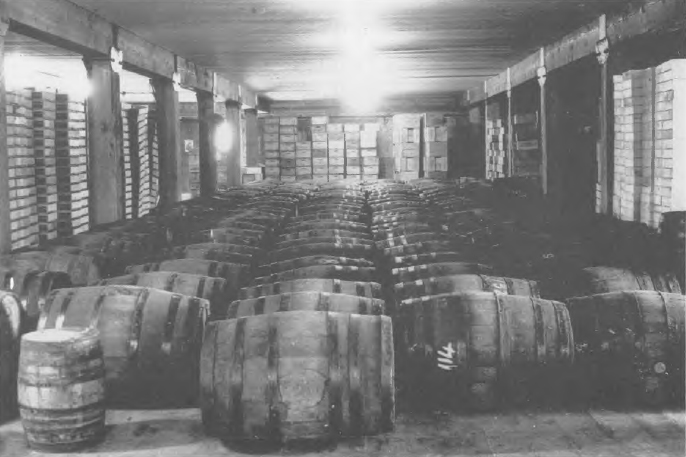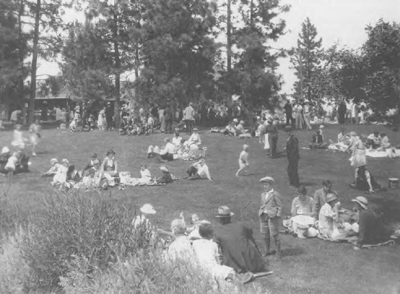News & Events More |
Competition and ChaosMarketing conditions after the demise of the Committee of Direction were similar to those which had prevailed before 1927-with the significant difference that the independent shippers had meanwhile grown in importance. Associated Growers now marketed only slightly over half the crop, as compared with over seventy per cent in 1927. Of the rest, Sales Service Ltd. had about twenty-five per cent, and B.C. Shippers, Occidental Fruit Company, and Kidstons Limited divided approximately twenty per cent among themselves. The remaining five per cent was distributed among various small shippers. Vignette: The Apple SellerThe apple seller is almost the symbol of the Depression. There on the street corner stands the unemployed man with a basket of apples, trying to sell enough to keep body and soul together. An unhappy sight, perhaps, but "it is a far more cheerful sight to see the apple vendors on the various busy corners than it is to see the long line of ill-clad men outside the relief station waiting for their daily dole."1 When in 1931 the City of Vancouver proposed to force these peddlers to buy business licenses, the B.C.F.G.A. stood up for the peddlers who were disposing of so many Okanagan apples, lobbying the Vancouver City Council on their behalf All that could be organized for the crop of 1931 was a voluntary Shippers' Council, representing between eighty and ninety per cent of the shipping tonnage. The Council collected information and made reports on sales, as well as agreeing on recommendations for prices and timing of shipments. From the start, the market was demoralized by shipments from "wild" shippers outside the Council, who threw their entire product directly onto the Prairies as soon as it was picked. In October, Associated Growers took the significant step of withdrawing from the Shippers' Council "in order to be in a position to meet the competition of the outlaw and wild shippers on the prairie markets." This was the first step away from the Associated's former policy of supporting, even when not directly profitable, all efforts to stabilize the supply of fruit to the market. The disorganization entailed in marketing the 1931 crop was apparent in the returns: apples brought an average of twenty-five cents a box less than the year before-and this on a crop almost twenty per cent lighter. Associated Growers' new policy was fully enunciated in its resolution of 1932: to cooperate with other shippers only if a binding agreement was made under which sales and price were controlled through one office, and markets were properly apportioned according to tonnage held. Otherwise, in order to hold onto its members, the Associated would throw its fruit into the early preferred markets in full competition with the independents, so as to get equivalent grower returns, even though this might depress prices for all the fruit. As F.M. Clement, Dean of Agriculture at the University of British Columbia, later put it when surveying the state of the Okanagan fruit industry, "the stabilization umbrella folded up completely and the rain of dissatisfaction dripped down the necks of all the growers." The threat of the crop of 1932, with a likely thousand carloads more of apples to sell than in 1931, resulted in formation of a voluntary Apple Cartel, made up of shippers controlling about ninety per cent of the crop. But its efforts to prevent glutting of markets failed miserably, since shippers outside the Cartel threw all their fruit on the market as soon as it was harvested. In addition, the signed Cartel members ignored the rulings of the Cartel, which, "as an informal organization, had no power to fix penalties for the violation of rules". 
Results were devastating. The average price per box of apples, f.o.b. Okanagan, dropped twenty cents from the year before, to $0.85. For some varieties and at some times, returns were considerably lower. At one point apples were sold in Vancouver at twenty-five cents a box! Many growers received only "red ink", bills from shippers for losses on fruit sold for less than the fiftycents- a-box sorting and packing costs. Almost no one received enough to pay production expenses. Since the grower's cost of production varied between 33 and 70 cents a box,7 any f.o.b. price below ninety-five cents meant a net loss to the grower. Typical was the experience of W.E. Haskins of Penticton, who received on an average twenty cents a box from his shipper, making a net loss of $2000 on his year's crop. In this gloomy situation, fruit growers faced the crop of 1933. The failure of all organizational efforts had been brought about by the stubborn minority which refused to cooperate. The O.K. Bulletin summed up the situation: One thing is quite evident: that it is apparently impossible for 100 per cent to join in any proposition by voluntary effort and it is abundantly apparent that as long as there is a minority outside any arrangement, the efforts of the majority will to a great extent be nullified. 
Conditions were ripe for more radical action. For the first time in many years, most fruit growers were actually out of pocket on the crop of 1932. As several analysts of agrarian protest have noted, the best times for such movements are when farmers, formerly prosperous, are faced with economic failure. "It's where the farmers had something a few years ago and have had it suddenly taken away, that the agitators find a responsive audience." Contact Us Hours: 9am - 4pm weekdays. t: 250-762-5226 |

